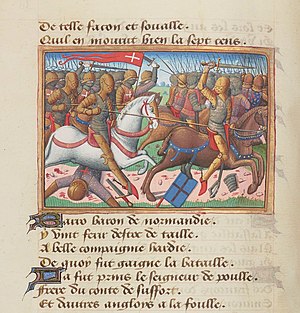Battle of La Brossinière
| date | September 16, 1423 |
|---|---|
| place | La Brossinière near Bourgon |
| output | French victory |
| Parties to the conflict | |
|---|---|
| Commander | |
| Troop strength | |
| 1520 men | 2000 armed, 800 archers |
| losses | |
|
low |
1200–1400 dead |
Chevauchées of the 1340s: Saint-Omer - Auberoche
Edward III. Campaign (1346/47): Caen - Blanchetaque - Crécy - Calais
War of the Breton Succession (1341–1364) : Champtoceaux - Brest - Morlaix - Saint-Pol-de-Léon - La Roche-Derrien - Tournament of Thirty - Mauron - Auray
France's allies : Neville's Cross - Les Espagnols sur Mer - Brignais
Chevauchées of the 1350s: Poitiers
Castilian Civil War & War of the Two Peter (1351–1375): Barcelona - Araviana - Nájera - Montiel
French counter-offensive: La Rochelle - Gravesend
Wars between Portugal and Castile (1369– 1385): Lisbon - Saltés - Lisbon - Aljubarrota
Battle of Northern France: Rouen - Baugé - Meaux - Cravant - La Brossinière - Verneuil
Jeanne d'Arc and the turn of the war: Orléans - Battle of the herring - Jargeau - Meung-sur-Loire - Beaugency - Patay - Compiegne - Gerberoy
The Battle of La Brossinière (also known as the Battle of la Gravelle ) took place on September 26, 1423 as part of the Hundred Years War . It occurred at La Brossinière (today: Bourgon ), between English and French troops, shortly after the hostilities between the two sides, which had been inactive since 1415, broke out again. The battle was fought on the Chemin gravelais, an ancient trade route that linked Anjou and Normandy .
background
In the summer of 1423 an English force of about 2,000 armed men and 800 archers under the command of William de la Pole set out from Normandy on a raid to Anjou and Maine . On their way they plundered the areas they crossed, took prisoners and finally conquered Segré . There they rounded up a herd of 1,200 bulls and cows from the town and the surrounding area before heading back towards Normandy.
In order to avenge this attack, the mother-in-law of the French King Charles VII , Queen Jolanthe of Aragón , ordered a force to be quickly raised. This should catch the looters on the way back and beat them. The command for this company was given to Ambroise de Loré , who had commanded Sainte-Suzanne since 1422 . He immediately wrote a letter to Jean VIII. D'Harcourt , Count of Aumale and Governor of Touraine , who was preparing a raid in Normandy at that time. They wanted to meet at Laval and bring Jean with them all the troops he had already signed on. At Le Bourgneuf-la-Forêt , Jean wrote a letter to Anna de Laval and asked her to send her twelve-year-old son André de Lohéac and Guy XIV. De Laval along with all available men under arms to the agreed meeting point.
He reached Laval on September 24th and the very next morning the combined forces of Harcourt, Laval and Loré set out on their way to pursue the English on the long-distance trade route. When they had finally approached them within three hours of marching and it was clear that they would pass La Brossinière, Harcourt conferred with the other generals. It was decided that Harcourt and Guy de Laval would go with their troops on foot as far as La Brossinière and take up a position there in order of battle. The remaining 200 men, led by Loré, would attack the English on horseback from behind.
Course of the battle
English scouts discovered the French outposts two hours after the French were in order. They forced them to retreat and pursued them until they retreated behind the French lines. The English then broke off the pursuit and withdrew.
Due to the looting, the English train carried a very long train, but marched in a disciplined marching order. Before the main English force could react to the discovery of the French troops in front of them, Loré led a cavalry attack against the English. These sought cover behind the wagons of the train. At the same time the French foot troops advanced, and soon the English were included. Although these fought valiantly, they could not last long. Soon the English soldiers turned to flee, but only a few succeeded. A total of between 1200 and 1400 of the English soldiers were killed on site or slain by the French while they were fleeing. William de la Pole and some other nobles escaped along with about 120 men. On the French side only one knight, John Le Roux, and a few armed men had died.
consequences
The victory of La Brossinière was enthusiastically received across France and should remain in the collective memory for a long time to come. For Charles VII, this battle was an important success at the beginning of his reign. Twelve-year-old André de Lohéac, later Marshal of France , was knighted along with some companions for participating in the battle .
literature
- Alphonse Angot: Bataille de la Brossinière. In: Alphonse Angot: Dictionnaire historique, topographique et biographique de la Mayenne. Volume 1: A - C. Goupil, Laval 1900 (reprint. Floch, Mayenne 1975).
- Jaques Salbert (ed.): La Mayenne des origines à nos jours (= L'Histoire par les Documents ISSN 0756-2799 ). Nouvelle édition. Éditions Bordessoules, Saint-Jean-d'Angély 1991, ISBN 2-903504-17-2 .
swell
- Guillaume Cousinot, Chroniques de la pucelle . Online source
